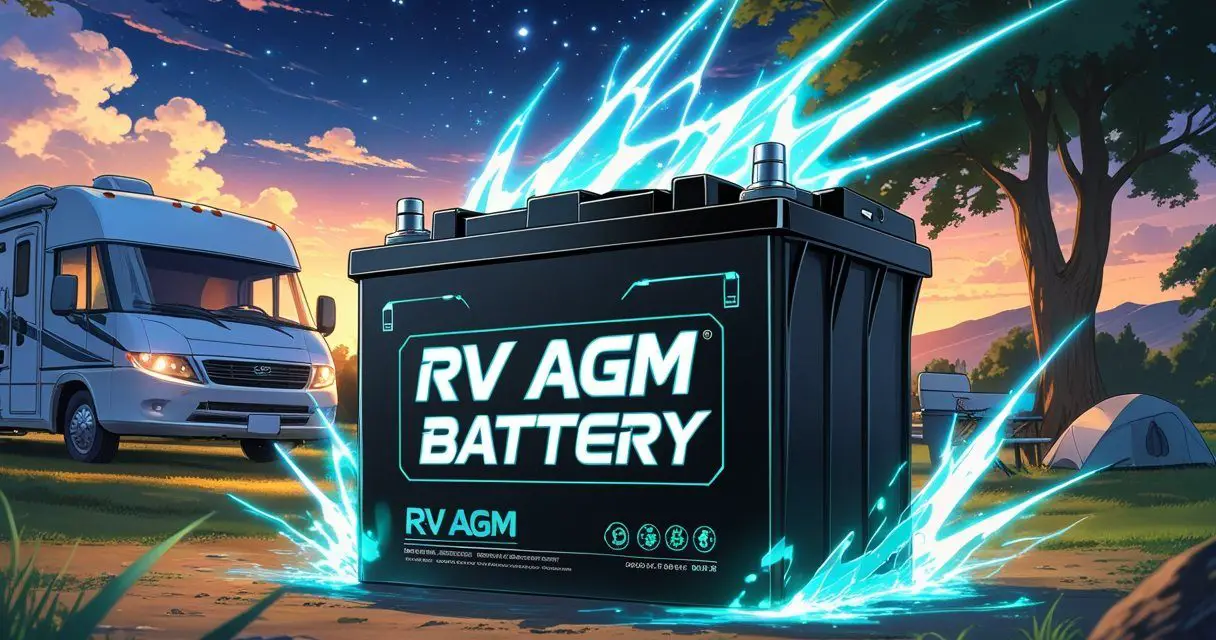Would you like to save this article?
Picture this: You’re parked at a pristine boondocking spot in the Utah desert, the nearest electrical hookup 50 miles away. The sun is setting, casting brilliant oranges and purples across the canyon walls, and you’re settling in for a perfect evening off-grid. You flip on your LED lights, fire up the refrigerator, and power up your laptop to edit those stunning photos you captured today. Your battery bank is humming along silently, providing reliable power without a care in the world.
This scenario is exactly why thousands of RVers are making the switch to AGM (Absorbed Glass Mat) batteries. But are AGM batteries good for RV applications? The short answer is a resounding yes – but let’s dive deep into why these powerhouses have become the gold standard for serious RVers who demand reliability, performance, and peace of mind.
What Makes AGM Batteries Special?
AGM technology isn’t just marketing hype – it represents a genuine leap forward in battery engineering. Developed in the early 1980s for military aircraft and vehicles, AGM batteries use a sophisticated design where sulfuric acid is absorbed into ultra-fine fiberglass mats between lead plates. This creates a completely sealed, spill-proof powerhouse that can handle the demands of life on the road.
The numbers tell the story: AGM batteries can deliver up to 5 times faster charging than traditional flooded batteries and offer an impressive 80% depth of discharge compared to just 50% for conventional lead-acid batteries This means you can use more of your battery’s capacity without damaging it – a game-changer for extended boondocking adventures.
Real-World Performance: The Statistics That Matter
When you’re living in your RV, theoretical specifications mean nothing if they don’t translate to real-world performance. Here’s where AGM batteries truly shine:
Lifespan and Durability:
- AGM batteries typically last 4-7 years in cycling applications and 6-10 years in standby applications
- They can handle 550 cycles at 50% depth of discharge versus just 300-400 cycles for standard flooded batteries
- In optimal conditions, premium AGM batteries can exceed 1,500 cycles at 30% depth of discharge
Charging Efficiency:
- AGM batteries accept charging rates up to 75% of their rated ampere-hour capacity
- They can recharge from 50% to 100% in approximately 4-6 hours with proper charging equipment
- Self-discharge rate is remarkably low at just 1-3% per month
Why RVers Are Making the Switch: The Compelling Advantages
1. Maintenance-Free Operation
Gone are the days of checking water levels and dealing with corrosive acid spills. AGM batteries are completely sealed and maintenance-free. One RV owner on Reddit shared their experience: “I’ve been running AGM batteries for 6 years now, and I’ve literally never had to do anything except connect them and charge them. Compare that to my old flooded batteries where I was constantly adding distilled water and cleaning corrosion.”
2. Vibration and Shock Resistance
RV life means constant movement, from smooth highways to rough forest service roads. AGM batteries are built like tanks – their sandwich construction makes them incredibly resistant to vibration and shock. NASCAR teams choose AGM batteries specifically for this reason, and your RV faces similar challenges on the road.
3. Temperature Performance
Whether you’re winter camping in Montana or summer camping in Arizona, AGM batteries maintain consistent performance across extreme temperatures. They operate effectively in temperatures ranging from -40°F to 140°F (-40°C to 60°C), with optimal performance between 68°F and 77°F (20°C to 25°C).
4. Safety and Installation Flexibility
AGM batteries can be mounted in any position except upside down, giving you incredible flexibility in your RV’s battery compartment design. There’s no risk of acid spills, even in an accident, making them significantly safer than traditional batteries.
The Economics: Are AGM Batteries Worth the Investment?
Let’s talk numbers. AGM batteries typically cost 1.5 to 2 times more than comparable flooded lead-acid batteries. A quality 100Ah AGM battery ranges from $175 to $400, while a comparable flooded battery might cost $100 to $200.
But here’s where the math gets interesting:
Total Cost of Ownership Analysis:
- AGM lifespan: 5-7 years average
- Flooded battery lifespan: 2-4 years average
- AGM usable capacity: 80% (80Ah from 100Ah battery)
- Flooded usable capacity: 50% (50Ah from 100Ah battery)
When you factor in longer lifespan, zero maintenance costs, and higher usable capacity, AGM batteries often deliver lower total cost per amp-hour over their lifetime. Plus, there’s the intangible value of reliability and peace of mind when you’re miles from civilization.
AGM vs. The Competition: A Head-to-Head Comparison
AGM vs. Lithium: The Heavyweight Battle
Lithium batteries are the new kids on the block, offering impressive performance but at a premium price. Here’s how they stack up:
AGM Advantages:
- Lower initial cost (AGM: $175-400 vs. Lithium: $500-1,200)
- Proven technology with widespread charger compatibility
- Better cold weather performance
- No complex battery management system required
Lithium Advantages:
- 50% lighter weight (crucial for RVs near weight limits)
- 5,000+ cycle lifespan vs. 550 for AGM
- 100% usable capacity vs. 80% for AGM
- Faster charging acceptance
AGM vs. Flooded Lead-Acid: No Contest
The comparison between AGM and traditional flooded batteries isn’t even close:
| Feature | AGM | Flooded Lead-Acid |
|---|---|---|
| Maintenance | Zero | Regular water addition |
| Usable Capacity | 80% | 50% |
| Charging Speed | 5x faster | Baseline |
| Spill Risk | None | High |
| Installation Position | Any (except upside down) | Upright only |
| Vibration Resistance | Excellent | Poor |
Real RVer Experiences: Success Stories from the Road
Case Study 1: The Full-Time Family
The Johnson family has been living full-time in their 35-foot Class A motorhome for three years. They installed four 100Ah AGM batteries (400Ah total) and report: “We can easily go 3-4 days without running our generator, even with the kids using tablets and us working remotely. Our old flooded batteries would barely last one day with the same usage.”
Case Study 2: The Boondocking Enthusiast
Sarah, a solo traveler who spends 300+ days per year boondocking, upgraded to six 100Ah AGM batteries paired with 600 watts of solar. “The difference is night and day. I used to worry constantly about battery levels. Now I can run my laptop, charge my camera equipment, and even use a small microwave without stress. The AGM batteries have been bulletproof for four years and counting.”
The Dark Side: AGM Battery Limitations
Honesty is crucial when making a significant investment. AGM batteries aren’t perfect:
1. Higher Initial Cost
The upfront investment is substantial, especially for larger battery banks.
2. Sensitive to Overcharging
AGM batteries require proper charging equipment. Using the wrong charger can significantly reduce lifespan.
3. Lower Energy Density
Compared to lithium, AGM batteries are heavier and bulkier for the same energy storage.
4. Temperature Sensitivity During Charging
Charging should be halted if the battery core reaches 120°F (49°C), which can be challenging in hot climates.
Installation and Maintenance: Setting Yourself Up for Success
Proper Charging is Critical
AGM batteries require specific charging profiles for optimal performance:
- Float voltage: 13.5-13.8V for 12V systems
- Cycle use voltage: 14.4-15.0V for 12V systems
- Maximum charging current: 30% of battery capacity (30A for 100Ah battery)
Monitoring and Care
While AGM batteries are maintenance-free, monitoring is still important:
- Check voltage regularly (12.7V = 100% charge, 12.2V = 50% charge)
- Avoid discharging below 50% for maximum lifespan
- Store batteries at 50-75% charge in temperatures between 32-80°F
Top AGM Battery Brands for RVers
Based on extensive research and RVer feedback, these brands consistently deliver excellent performance:
1. Lifeline Batteries
Premium pricing but exceptional longevity and performance. Popular among serious RVers.
2. Renogy AGM Batteries
Excellent balance of price and performance, with over 230,000 units sold worldwide.
3. VMAX Tanks
Specifically designed for RV and marine applications, with strong deep-cycle performance.
4. Interstate Batteries
Widely available with good dealer support network across North America.
The Verdict: Are AGM Batteries Right for Your RV?
After analyzing the data, examining real-world performance, and considering total cost of ownership, the answer to “are AGM batteries good for RV” is a clear yes – with caveats.
AGM batteries are ideal if you:
- Want maintenance-free operation
- Plan to boondock regularly
- Value reliability and safety
- Have a moderate budget for battery investment
- Don’t want to deal with complex battery management systems
Consider alternatives if you:
- Are extremely weight-conscious
- Want maximum energy density
- Plan minimal off-grid camping
- Have a very tight budget
- Want the absolute longest lifespan (lithium)
Future-Proofing Your Investment
The RV industry is rapidly evolving, but AGM technology remains relevant and valuable. Here’s why AGM batteries will continue to be a smart choice:
- Proven reliability with decades of real-world performance data
- Universal compatibility with existing RV electrical systems
- Reasonable pricing that makes upgrading accessible
- Recycling infrastructure that’s well-established
Taking Action: Your Next Steps
If you’ve decided that AGM batteries are right for your RV adventures, here’s your roadmap:
- Calculate your power needs using our RV power audit worksheet
- Size your battery bank (most RVers find 200-400Ah suitable for weekend trips, 400-800Ah for extended boondocking)
- Verify your charging system is AGM-compatible
- Choose quality batteries from reputable manufacturers
- Install proper monitoring to track performance and health
Remember, your battery system is the heart of your RV’s electrical system. Investing in quality AGM batteries isn’t just about power – it’s about freedom, reliability, and peace of mind as you explore this incredible country.
The open road is calling, and with AGM batteries powering your adventure, you’ll be ready to answer with confidence. Whether you’re chasing sunsets in the Southwest, leaf-peeping in New England, or finding solitude in Alaska’s wilderness, your AGM battery bank will be the silent partner that makes it all possible.
Sources:





